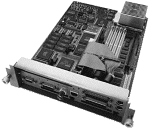

 |
 |
 Technical Specifications
Technical Specifications
Serial Y Cable Pinout |
SROM LED CODESOne of the first steps when troubleshooting hardware problems with your Universal Desktop Box is to examine the SROM LED failure code. These LED indicators are found at the rear of the UDB between the Twisted pair ethernet connector and the serial port. These diagnostic LED indicate the symptom of any problem that occurs during initialization or the Power On Self-Test, POST. When you turn on the system, the SROM initializes the CPU, core logic, and memory. During power on, the CPU loads the POST from the SROM. Typically, the POST reports errors that prevent the console from booting. During power on, if the system fails a test, the LED flashes to indicate that the test failed. On the VX40 model, the diagnostic LED also flashes at the beginning of each self-test. The diagnostic LED on the system box flashes at power-up. On the VX40 model, the LED also flashes once, briefly, for each sequence number displayed. If the SROM code completes testing without errors, the LED remains off. If an error occurs, the LED flashes a hexadecimal code which can be decoded and compared to the table below for corrective action. |
CODE |
DESCRIPTION |
RECOMMENDED ACTION | |
F |
Failed while sizing memory. | VX41 and VX42, first replace the cache SIMM. If this does not
fix the problem, continue with the recommended action for VX40 models.
VX40, replace memory SIMM modules until no failure occurs. If replacing the SIMMs does not fix the problem, replace the system board. | |
E |
Failed while configuring memory. | ||
D |
Testing for mapped out MCRs. | ||
C |
Undocumented code | ||
B |
Configured memory OK | ||
A |
Testing 8M memory with internal data cache OFF and backup cache OFF. | ||
|
| |||
9 |
Testing 8M memory with internal data cache OFF and backup cache ON. | VX40, replace the system board
VX41 and VX42, first replace the cache SIMM. If replacing the cache SIMM does not fix the problem, replace the system board. | |
|
| |||
8 |
Testing 8M memory with internal data cache ON and backup cache OFF | Replace the system board. | |
|
| |||
7 |
Testing 8M memory with internal data cache ON and backup cache ON | VX40, replace the system board.
VX41 and VX42, first replace the cache SIMM. If replacing the cache SIMM does not fix the problem, replace the system board. | |
|
| |||
6 |
Failed to find SIO while scanning PCI ID lines. | Replace the backplane. If a new backplane does not fix the problem, replace the system board | |
5 |
Testing PCI data path using SIO. | ||
|
| |||
4 |
Testing flash ROM header, checks manufacturing code. | Replace the system board. | |
3 |
Failed flash ROM size field out of range. | ||
2 |
Testing flash ROM checksum, after loaded data. | ||
|
| |||
1 |
Done with flash ROM load, either ROM0 or ROM2 | No action. | |
0 |
Jumping to SRM console prompt. | No action.
If the SROM code is unable to load the SRM console from flash ROM, or there is a checksum error after loading the flash code, then it attempts to load ARC from flash ROM. If SROM cannot load ARC, then an error code flashes on the back of the system box. | |
|
| |||